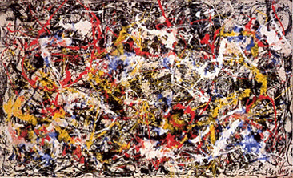
« PREVIOUS ENTRY
KFC ad uses steganography to hack Tivo

Dig this: The physicist Richard Taylor has developed a technique for authenticating Jackson Pollock “poured” paintings — by analyzing their fractal dimensions.
Taylor, who also has a degree in art theory, got interested in Pollock’s work back in the 1990s. He suspected that Pollock’s famously chaotic paintings — created by the artist standing over the canvases and dripping paint — displayed fractal mathematics: They had self-replicating geometry, such that the larger shapes in the picture were similar to the tiny shapes you’d see if you looked at closely the edges of the splatters. He put computer-generated grids over images of five Pollock splatter paintings and, sure enough, there they were: Two sets of fractal patterns, one that resolved on a 5 mm scale, and another on a 1 mm scale.
There were two reasons to suspect that Pollock’s paintings might obey fractal geometry. Moving around a large canvas laid on the ground, the artist let paint fly from all angles, using his whole body. Human motion is known to display fractal properties when people restore their balance, says Taylor, and films of Pollock seem to show him painting in a state of ‘controlled off-balance’. Second, the dripping and pouring itself could be a chaotic process. [snip]
“Pollock was in control,” says Taylor. The large-scale fractals are a fingerprint of the artist’s body motion, he notes. “But the small-scale fractals are also to do with his choices — his height over the canvas, the fluidity of his paint, angle and force behind the trajectory, and so on.”
Cool enough, eh? Now dig this: Last year, 32 new “poured” paintings — purportedly by Pollock — were uncovered for the first time. Art historians have been arguing heatedly over whether they’re real Pollocks, because the official Pollock authentication board was disbanded in 1995 when it was assumed there were no new Pollocks to find. One of the former members of the board is launching a new show of Pollock’s work that includes some the new-found paintings; after seeing one of Taylor’s papers on his Pollock-fractal work (in Pattern Recognition Letters, a just awesomely-titled academic journal), the art expert sent Taylor six of the new paintings to analyze.
His verdict? They didn’t display Pollock’s distinctive fractal patterns. While Taylor says his technique shouldn’t be regarded as a final word on Pollock authenticity, it’s a pretty nifty use of fractal math.
(Thanks to Erik Weissengruber for this one!)
I'm Clive Thompson, the author of Smarter Than You Think: How Technology is Changing Our Minds for the Better (Penguin Press). You can order the book now at Amazon, Barnes and Noble, Powells, Indiebound, or through your local bookstore! I'm also a contributing writer for the New York Times Magazine and a columnist for Wired magazine. Email is here or ping me via the antiquated form of AOL IM (pomeranian99).

ECHO
Erik Weissengruber
Vespaboy
Terri Senft
Tom Igoe
El Rey Del Art
Morgan Noel
Maura Johnston
Cori Eckert
Heather Gold
Andrew Hearst
Chris Allbritton
Bret Dawson
Michele Tepper
Sharyn November
Gail Jaitin
Barnaby Marshall
Frankly, I'd Rather Not
The Shifted Librarian
Ryan Bigge
Nick Denton
Howard Sherman's Nuggets
Serial Deviant
Ellen McDermott
Jeff Liu
Marc Kelsey
Chris Shieh
Iron Monkey
Diversions
Rob Toole
Donut Rock City
Ross Judson
Idle Words
J-Walk Blog
The Antic Muse
Tribblescape
Little Things
Jeff Heer
Abstract Dynamics
Snark Market
Plastic Bag
Sensory Impact
Incoming Signals
MemeFirst
MemoryCard
Majikthise
Ludonauts
Boing Boing
Slashdot
Atrios
Smart Mobs
Plastic
Ludology.org
The Feature
Gizmodo
game girl
Mindjack
Techdirt Wireless News
Corante Gaming blog
Corante Social Software blog
ECHO
SciTech Daily
Arts and Letters Daily
Textually.org
BlogPulse
Robots.net
Alan Reiter's Wireless Data Weblog
Brad DeLong
Viral Marketing Blog
Gameblogs
Slashdot Games